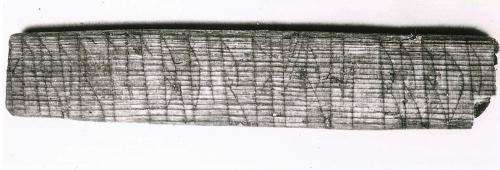February 14, 2014 weblog
Runologist breaks jotunvillur code-on-a-stick

(Phys.org) —A key to Ancient Norse messaging has been discovered by a Norwegian academic K Jonas Nordby; he has cracked an ancient messaging code. This is the 'jotunvillur' code, dating back to the 12th or 13th century in Scandinavia. The Guardian said the code has been puzzling experts for years. Runologist K. Jonas Nordby, University of Oslo, who is working on his doctorate, cracked the code via a wooden stick from the Bergen Wharf in Norway. Nordby has studied a number of runic codes in Northern Europe; he wrote in the International Journal of Runic Studies that "Inscriptions with rune-like symbols continue to challenge the ingenuity of runologists. Such inscriptions may take the form of meaningless scribbles, complex bind-runes, or garbled texts with a hidden message."
Runes are a system of writing, and the signs were used by Nordic and Germanic groups. Runology is the study, publishing, and interpretation of runic texts. The medieval writers would carve runic codes on to sticks of wood, stones and other objects. A report about them in ScienceNordic said the codes have been seen across Scandinavia, the British Isles and elsewhere where runes were in use. Scholars have tried through the years to decode the various systems of runic signs, and many inscriptions have gone through interpretation. As for the wharf discovery, two men, Sigurd and Lavrans, carved their names in code and in standard runes on the wooden stick. Nordby studied the stick. All runes have names, and the jötunvillur code works by exchanging the rune sign with the last sound in the rune's name, said ScienceNordic.
While many enjoy the drama and mystique of codes as highly secret revelations about war plans, enemy tactics or hidden treasures, Nordby has arrived at a different understanding. Rune codes were more likely to be the text messaging of their time, dealing with the everyday, and sometimes playful. "It was very common to use codes. Much of the population mastered them. That's why I think they were something people picked up at the same time they learned the runic alphabet. If you had learned to read and write, you had also learned codes," said Nordby in ScienceNordic. Commenting on the Bergen discovery, Henrik Williams, a professor at Uppsala University's Department of Scandinavian Languages, considered it helpful for an understanding "that there were more codes than we were aware of. Each runic inscription we interpret raises our hopes of soon being able to read more. This is pure detective work and each new method improves our chances."
More information:
www.theguardian.com/books/2014 … nologist-jotunvillur
www2.teknat.uu.se/forskning/uu … mr=90&id=487&lang=en
www.forskning.no/artikler/2014/januar/379474
© 2014 Phys.org


















